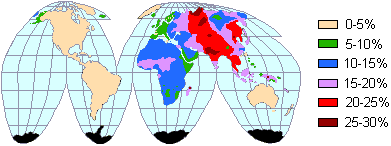Overview
The goal of
this tutorial is to help you objectively analyze the phenomena of race and ethnicity
![]() as
well as some of the world wide patterns of discrimination based on them. In doing
this, it is important to suspend our own biases as much as possible and to take a
cultural relativity approach. That is to
say, we must not let our own cultural biases get in the way of understanding the lives of
other people. This is a very difficult task given the emotionally charged feelings
and deep beliefs that most people have concerning race and ethnicity. However, suspending
these attitudinal barriers in order to gain a better understanding of the phenomena is
worth the effort.
as
well as some of the world wide patterns of discrimination based on them. In doing
this, it is important to suspend our own biases as much as possible and to take a
cultural relativity approach. That is to
say, we must not let our own cultural biases get in the way of understanding the lives of
other people. This is a very difficult task given the emotionally charged feelings
and deep beliefs that most people have concerning race and ethnicity. However, suspending
these attitudinal barriers in order to gain a better understanding of the phenomena is
worth the effort.
Have you ever
asked yourself what are the defining characteristics of being "white" or
"black" in America today? Is it solely a matter of skin color? Are
other factors as important or even more important? What makes someone
"Hispanic
![]() "
or "Latino
"
or "Latino
![]() ."
Is it language? Country of origin? Cultural
traditions? Family values? Religion? Skin color? Can you be
"white" or "black" and Hispanic at the same time?
Can you be a non-Spanish speaking member of one of Mexico's Indian communities
and be Hispanic? Are people from Spain and Portuguese speaking
Brazilians Hispanic? The
answers to these questions probably are not entirely clear to you nor are they to most
Americans. It addition, the answers very likely will
differ depending on the region of America in which you live.
."
Is it language? Country of origin? Cultural
traditions? Family values? Religion? Skin color? Can you be
"white" or "black" and Hispanic at the same time?
Can you be a non-Spanish speaking member of one of Mexico's Indian communities
and be Hispanic? Are people from Spain and Portuguese speaking
Brazilians Hispanic? The
answers to these questions probably are not entirely clear to you nor are they to most
Americans. It addition, the answers very likely will
differ depending on the region of America in which you live.
|
|
 |
 |
||
|
Test yourself. |
||||
|
Click
the button to see |
||||
The ways in which we personally acquire our own group identities are often complex. Similarly, the way we assign group identity to others is not always straight forward. Race and ethnic group labels in America are not clearly based on criteria that everyone understand, agree with, and can easily use. As a result, someone else may label you in a way that you consider inaccurate and very offensive. This can instantly create a barrier to open communication even if the slight was unintended.
To comprehend the human diversity of the United States or any other
country, it is important to first understand the criteria commonly used for making group
distinctions. These generally are based on cultural and/or biological factors.
Americans tend to see each other in terms of age, economic class, religion, gender
![]() , ethnicity, and race. We are usually a member
of a particular group for each of these criteria. Which of our group identities is
most important varies with the social situation. In America today, gender,
ethnicity, and race often have the most far ranging impacts on us as individuals.
, ethnicity, and race. We are usually a member
of a particular group for each of these criteria. Which of our group identities is
most important varies with the social situation. In America today, gender,
ethnicity, and race often have the most far ranging impacts on us as individuals.
Ethnicity refers to selected cultural and sometimes physical characteristics used to classify people into groups or categories considered to be significantly different from others. Commonly recognized American ethnic groups include American Indians, Latinos, Chinese, African Americans, European Americans, etc. In some cases, ethnicity involves merely a loose group identity with little or no cultural traditions in common. This is the case with many Irish and German Americans. In contrast, some ethnic groups are coherent subcultures with a shared language and body of tradition. Newly arrived immigrant groups often fit this pattern.
It is important not to confuse the term
minority with
ethnic
group. Ethnic groups may be either a minority or a majority in a
population. Whether a group is a minority or a majority also is not an absolute fact
but depends on the perspective. For instance, in some towns along the southern
border of the U.S., people of Mexican ancestry are the overwhelming majority population
and control most of the important social and political institutions but are still defined by state
and national governments as a minority. In small
homogenous societies, such as those of
hunters and gatherers and pastoralists
![]() , there is essentially only one ethnic
group and no minorities.
, there is essentially only one ethnic
group and no minorities.
 |
|
| African American | |
 |
|
| Senagalese | |
For many people, ethnic categorization implies a connection between
biological inheritance and culture. They believe
that biological inheritance determines much
of cultural identity. If this were true, for instance, African American cultural
traits, such as "black English", would stem from genetic inheritance.
We now know that this
is not true--biological race and culture are not the
same thing. The pioneering
English anthropologist Edward Tylor
may have been the first scientist to understand this fact
and to state it in print. In 1871, he wrote that cultural traits are
entirely learned. Subsequently, a baby can be placed into another culture shortly after birth and can be
thoroughly enculturated
![]() to that culture,
regardless of their skin color, body shape, and other presumed racial features.
For example, both women in the photographs
on the right are genetically African, but
they do not speak the same language nor do they share any other significant cultural
patterns due to the fact that they were brought up in very different societies. The
African American woman is far more similar culturally to her European American
neighbors than to the West African woman
from Senegal.
to that culture,
regardless of their skin color, body shape, and other presumed racial features.
For example, both women in the photographs
on the right are genetically African, but
they do not speak the same language nor do they share any other significant cultural
patterns due to the fact that they were brought up in very different societies. The
African American woman is far more similar culturally to her European American
neighbors than to the West African woman
from Senegal.
A race is a
biological subspecies
![]() , or variety of a species,
consisting of a more or less distinct population with anatomical traits that distinguish
it clearly from other races. This biologist's definition does not fit the reality of
human genetic variation today. We are an extremely homogenous
species genetically. As a matter of fact, all humans today are
99.9% genetically identical, and most of the variation that does occur is
in the difference between males and females and our unique personal traits.
This homogeneity is very unusual in the animal kingdom. Even our closest
biological relatives, the chimpanzees have 2-3 times more genetic variation than people.
Orangutans have 8-10 times more variation.
, or variety of a species,
consisting of a more or less distinct population with anatomical traits that distinguish
it clearly from other races. This biologist's definition does not fit the reality of
human genetic variation today. We are an extremely homogenous
species genetically. As a matter of fact, all humans today are
99.9% genetically identical, and most of the variation that does occur is
in the difference between males and females and our unique personal traits.
This homogeneity is very unusual in the animal kingdom. Even our closest
biological relatives, the chimpanzees have 2-3 times more genetic variation than people.
Orangutans have 8-10 times more variation.
It is now clear that our human "races" are primarily cultural creations, not biological realities. The commonly held belief in the existence of human biological races is based on the false assumption that anatomical traits, such as skin color and specific facial characteristics, cluster together in single distinct groups of people. They do not. There are no clearly distinct "black", "white", or other races.
The popularly held view of human races ignores the fact that anatomical traits supposedly identifying a particular race are often found extensively in other populations as well. This is due to the fact that similar natural selection factors in different parts of the world often result in the evolution of similar adaptations. For instance, intense sunlight in tropical latitudes has selected for darker skin color as a protection from intense ultraviolet radiation. As a result, the dark brown skin color characteristic of sub-Saharan Africans is also found among unrelated populations in the Indian subcontinent, Australia, New Guinea, and elsewhere in the Southwest Pacific.
 |
 |
 |
||
| Sub-Saharan African |
Fijian |
South Indian |
 |
|
| Distribution of the B blood type allele among humans | |
The actual patterns of
biological variation among humans are extremely complex and constantly changing.
They can also be deceptive. All of us could be classified into a number of different
"races", depending on the traits
that are emphasized. For example, if
people are sorted on the basis of stature or blood types, the geographic groupings
will be
clearly different from those defined on the basis of skin color. Using the B blood
type for defining races, Australian Aborigines
![]() would be lumped together with most Native
Americans. Some Africans would be in the same race as Europeans while others would
be categorized with Asians.
would be lumped together with most Native
Americans. Some Africans would be in the same race as Europeans while others would
be categorized with Asians.
Historically in the Western World, human "races" have been defined on the basis of a small number of superficial anatomical characteristics that can be readily identified at a distance, thereby making discrimination easier. Focusing on such deceptive distinguishing traits as skin color, body shape, and hair texture causes us to magnify differences and ignore similarities between people. It is also important to remember that these traits are no more accurate in making distinctions between human groups than any other genetically inherited characteristics. All such attempts to scientifically divide humanity into biological races have proven fruitless.
In the final analysis, it is clear that people, not nature, create our identities. Ethnicity and supposed "racial" groups are largely cultural and historical constructs. They are primarily social rather than biological phenomena. This does not mean that they do not exist. To the contrary, "races" are very real in the world today. In order to understand them, however, we must look into culture and social interaction rather than biology.
